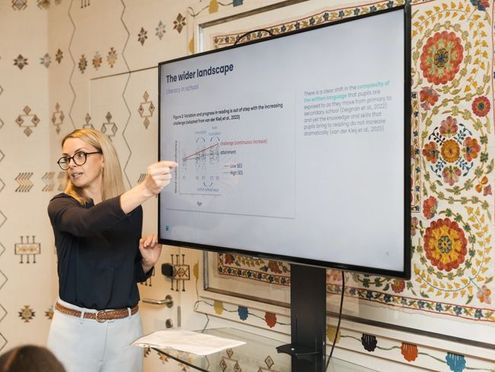Whilst most learners begin to acquire language long before they start school, it cannot be taken for granted that vocabulary will develop on its own without explicit guidance or formal instruction. As learners get older and advance through school, the quantity and variety of vocabulary they are required to retain and use correctly increases significantly. Without an effective strategy in place for teaching vocabulary, learners can fall behind and become overwhelmed. This is why a tiered approach to vocabulary instruction plays such an important role in the classroom, both to help teachers provide targeted instruction and support learners in understanding why and when they need to use certain words and phrases.
What is tiered vocabulary, what purpose does it serve in supporting teachers to deliver effective vocabulary instruction at school, and how important is tiered vocabulary instruction in the development of Bedrock’s literacy curricula?
What is the tiered approach to vocabulary?
A concept initially developed by Isabel Beck & Margaret McKeown (1987), tiered vocabulary is a ranking system for language which separates words into three distinct tiers depending on their usage, role, and specificity of meaning.
Tiered vocabulary involves placing words into different categories based on their simplicity or complexity, whether they are informal everyday phrases or more academic in nature, and whether they are general words that can have multiple meanings, or they are used specifically in a certain context. It is useful to provide an overview of the tiered system before going on to explain the role it plays in vocabulary instruction at school.
Tier 1 vocabulary
Tier 1 vocabulary consists of high frequency words, most commonly used in spoken language, which do not typically have multiple meanings. These can be basic nouns such as ‘house’, ‘dog’, and ‘phone’, which learners come across in normal everyday conversation. In most cases, learners will have already acquired this basic level of language prior to starting school and they can continue to develop their tier 1 vocabulary on a day-to-day basis when communicating with their peers and teachers, in tandem with their formal learning.
Tier 2 vocabulary
Tier 2 vocabulary is also high in frequency but is predominantly used in written language. Examples include words such as, ‘analyse’, ‘context’ and ‘sufficient’. More complex, nuanced and academic in nature, Tier 2 vocabulary is not subject specific; it can have multiple meanings and requires a much higher degree of literacy for learners to comprehend. A large quantity of Tier 2 vocabulary is introduced to learners when they start secondary school, which is where language gaps and vocabulary acquisition issues can become more apparent.
Tier 3 vocabulary
Tier 3 vocabulary is low frequency, subject-specific language that is used only in reference to particular concepts, topics and processes. Tier 3 language requires learners to possess a certain level of subject knowledge in order to understand the specific terminology in question: for example, ‘hypotenuse’, ‘tectonic’ or ‘photosynthesis’. It is the language used by subject specialists when discussing their field, such as historians, artists, scientists, and engineers, and it is the specific vocabulary used in the classroom to teach these subjects.
Does using this system of categorising words help with vocabulary instruction?
According to the Oxford Language Report (2020) “nine out of ten teachers think that the transition between primary and secondary school highlights vocabulary issues with the variety, quantity and purpose of language dramatically shifting.” The report also found that, on average, learners are faced with up to four times more vocabulary per day at secondary school compared to primary school. With the word gap being further exacerbated by the COVID-19 lockdowns and remote learning, 92% of teachers have returned to the classroom even more concerned about the challenges they face in helping learners to overcome their “vocabulary deficit.”
It is at secondary school where learners find themselves immersed in much more ambitious and complex language across all subject areas (Tier 2), as well as encountering a multitude of subject-specific terms (Tier 3) as they navigate their way through their daily timetable of lessons in English, Mathematics, Science, History, Geography and more.
Using a tiered framework in vocabulary instruction enables teachers to adopt a more systematic approach when teaching vocabulary and helps educators to assess current literacy levels accurately, monitor progress and identify any knowledge gaps for each learner. This framework helps to alleviate some of the barriers to implementing tiered vocabulary instruction within all lessons across the curriculum.
Unlike many Tier 1 words which can be learnt through everyday interactions, in most instances, Tier 2 vocabulary needs to be explicitly taught. Having a framework in place which clearly categorises the more academic and sophisticated language found in Tier 2 is a useful aid for teachers, flagging up which words will require explicit instruction, practice, and discussion in the classroom in order for learners to be able to use this level of vocabulary themselves.
By having this tiered structure in place, teachers will also be able to more clearly identify when words should be taught in a specific context, rather than for general academic use across all subjects. This helps to ensure subject-specific Tier 3 vocabulary instruction is undertaken in the appropriate format and framework.
In addition to making vocabulary instruction more systematic, the tiered approach helps teachers to gauge more distinctly where each learner currently is on their literacy journey and to determine which learners will require additional support to reach the same level as their peers. There are many factors which account for the varying levels of literacy amongst learners of the same age, including the variety and quantity of Tier 2 vocabulary learners encounter at home and their ability to read for pleasure. As each child’s situation can vary greatly, Tier 2 vocabulary acquisition cannot be taken for granted and it must be formally taught at school. Using the tiered system of categorising words depending on their prevalence, context and complexity provides key indicators to where learners are succeeding and where they are struggling, helping teachers to formulate effective lesson plans and robust strategies for teaching vocabulary. With as many as 43% of Year 7 pupils stating that they feel their vocabulary deficit is affecting their overall attainment, a methodical and impactful foundation for vocabulary instruction is crucial for their academic progress and personal development.
Do learners need to be aware of tiered vocabulary?
Arguably, it is not essential, or indeed helpful, for learners to be consciously aware that they are choosing to use vocabulary that belongs to Tier 1, 2 or 3 at any given time. Attempting to make a deliberate choice between the tiers could even cause confusion and risk inhibiting their confidence when speaking and writing. It is, however, extremely useful for learners to be aware of the different levels of language, how to select vocabulary appropriately in each situation and the impact the language they choose to use may have on the listener or reader.
Using the tiered system in the classroom will help learners to distinguish between more basic and complex language, how to apply vocabulary effectively and accurately, and enrich their own knowledge and use of words. An awareness of the tiered system also aids learners in understanding why they are learning certain words in a particular context, which is helpful for Tier 3 vocabulary instruction.
How does Bedrock support tiered vocabulary instruction?
Here at Bedrock Learning, we know that vocabulary acquisition is the foundation of academic success, as well as being key to personal growth and mental wellbeing. Possessing a rich and varied vocabulary and the ability to understand and use words correctly and confidently, is one of the driving forces that affects our self-esteem, contributes to our sense of identity, and determines how we grow and develop throughout our lives. We also know that both learning and teaching vocabulary can be challenging for a variety of reasons, which is why we have created an immersive, impactful and innovative digital vocabulary curriculum which supports learners, teachers and parents to achieve their goals.
We have developed a range of effective strategies, engaging content and interactive material designed to keep learners on track, motivated and enjoying the learning process whilst enriching their vocabulary following the tiered approach.
Our programme supports Tier 2 vocabulary instruction at school, provides a solid curriculum for teaching and learning Tier 3 subject-specific disciplinary literacy, and offers plenty of opportunities for tailored home learning. All of our programmes have a progress tracking feature which can be accessed by learners, teachers and parents, as well as having a record of every new word that has been learned.
How does Bedrock contribute to effective Tier 2 vocabulary acquisition?
We immerse learners in a digital learning environment that is rich in knowledge and contextualised Tier 2 vocabulary. By placing vocabulary in a context that learners find interesting and relevant we are able to introduce and build upon language that is accessible yet ambitious. Over time we can equip learners with the level and variety of academic language that is essential for both academic attainment and the achievement of their personal goals.
We present our Tier 2 vocabulary curriculum in a range of exciting and engaging formats, in order to retain the interest of learners, support their progress and promote consistency in their learning. This includes original fiction and non-fiction texts read by human narrators, placing vocabulary in context and enhancing the cultural knowledge of learners in the process.
Being able to utilise Tier 2 vocabulary effectively at school is not the sole aim of our programme - we also want to instil in learners a genuine love of reading for pleasure that will endure into adulthood and make their lives all the richer because of it.
What is Bedrock’s approach to Tier 3 vocabulary instruction?
Bedrock Mapper provides a solid foundation for learning targeted, subject-specific words and phrases, by compiling lists of key terminology related to each discipline. Subject-specific vocabulary acquisition can be easily monitored and tracked across each subject area, significantly increasing each learner’s confidence and accuracy when using terminology related to certain topics and areas of expertise.
Our targeted, research-based approach to Tier 2 and Tier 3 vocabulary curricula supports learners at school and at home to become fluent and confident communicators in a variety of settings.
Summary
Using the tiered system to categorise words depending on whether they are basic or academic, general or specific, or more prevalent in speech or written texts, can help teachers to strengthen the direction, purpose and overall success of their vocabulary instruction in a number of ways. Whilst many Tier 1 words tend to be naturally acquired by learners at home and in everyday situations, knowledge gaps and differing levels of literacy can become particularly apparent when learners begin secondary school, which is why explicit instruction for Tier 2 and Tier 3 vocabulary is so important.
Applying a tiered framework to vocabulary instruction enables teachers to identify areas of strengths and areas where knowledge gaps exist for each learner. These can depend on the level of Tier 2 language learners encounter outside of school and through reading on their own, amongst other factors. A tiered approach to vocabulary also provides a clear indication of when and why certain words need to be learnt, helping learners to appreciate the relevance and importance of what they are learning in relation to subject-specific Tier 3 terminology.
Bedrock’s dynamic Tier 2 vocabulary and disciplinary literacy curricula can support and enhance the teaching and learning of Tier 2 and Tier 3 vocabulary both at school and at home. Our tailored lessons and immersive, knowledge-rich programmes complement teaching in the classroom and independent home study in order to improve vocabulary levels and support learners to achieve the fluency, accuracy and self-confidence required to communicate effectively in their academic and personal lives.




